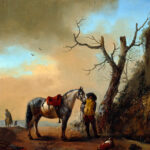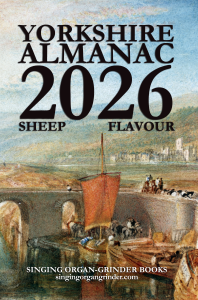18 August 1730: Elizabeth Hawksworth endeavours to mount a horse behind her husband
John Hobson. 1877. The Journal of Mr. John Hobson, Late of Dodworth Green. Yorkshire Diaries and Autobiographies in the Seventeenth and Eighteenth Centuries. Ed. Charles Jackson. Durham: Surtees Society. A (morbid) compendium of everyday England. It is sometimes unclear whether the date given is that of an occurrence or that on which news reached his capacious ears. Get it:
.Excerpt
Elizabeth Hawksworth, formerly wife of Samuel Sadler, afterwards of Edward Bramhall, died at Shepperd’s Castle, of a fall from a horse which she received the 18th instant, at Peniston races. As she was getting up behind her husband the horse threw them both.
Comment
Comment
I love the editor’s note:
This post equitem adventure on the part of this unfortunate lady needs explanation to the present generation, for there are probably few now living who have ever seen such a feat effected. In days when roads were bad, carriages were few, and railroads were not dreamed of, it was the custom for many females of different ranks in life to take up their position on horseback upon a comfortable seat called a pillion (from pillow) behind their husbands, servants, or others, as the case might be. I can well recollect, in the first quarter of the present century, some of the older race of farmers’ wives coming to the markets at Doncaster in this style, with their baskets of eggs and butter resting before them upon their knees. Swift has:
The horse and pillion both were gone;
Phyllis, it seems, was fled with John.Captain Adam Eyre, in his journal, Jan. 23, 1646, speaks of having borrowed a mare ‘to carry my wife and myself.’ 1646–7 March 17, Robert Eyre having come to him on business, ‘he promised to ride with his wife to Derby, and wished me to bring him a pillion seat to carry her on.’ 1647, May 11, speaks about his wife and himself both riding upon one horse, and having a dangerous fall. Same year, Aug. 24, ‘I went to Birchworth, and Priscilla rid behind me.’ In this fashion Queen Elizabeth, when she rode into the city, placed herself behind her Lord Chancellor. The side-saddle, it is true, was in use at that period, but none but the most experienced riders ventured with it. An anecdote is related in ‘Ramsay’s Reminiscences of Scottish Life and Character,’ p. 64, regarding an old Gallowegian lady of a period when a too liberal conviviality sometimes led to awkward occurrences. An old laird was returning from a supper party with his lady mounted behind him on horseback. On crossing the river Urr, at a point where it joins the sea, the old lady dropped off, but was not missed till her husband reached his door. The party who were despatched in search of her arrived just in time to find her remonstrating with the advancing tide, which trickled into her mouth, in these words: ‘No anither drap; neither het nor cauld.’ The Daily News of Oct. 19, 1874, says: ‘In our grandfathers’ time it was not unusual for a lady to be married in her riding habit, and jog off for her honeymoon on a pillion with her arms round her husband’s waist. The apparently meaningless leather belt still worn by grooms is what Mr. Tylor would call a survival of the practice of riding pillions. The fair equestrian who of necessity sat behind held on by this leathern girdle.’ A ‘male pylyon,’ i.e. a pillion to carry a maille or portmanteau, containing treasure, is mentioned in the steward’s accounts of Edw. Seymour, earl of Hertford, 1537.
Something to say? Get in touch
Original
Elizabeth Hawksworth, formerly wife of Samuel Sadler, afterwards of Edward Bramhall, died at Shepperd’s Castle, of a fall from a horse which she received the 18th instant, at Peniston races. As she was getting up behind her husband the horse threw them both.
46 words.
Similar
 31 October 1674: Riding home to Pontefract from Wakefield fair, a sozzled Silvanus Rich enters the River Calder in flood at Wakefield bridge
31 October 1674: Riding home to Pontefract from Wakefield fair, a sozzled Silvanus Rich enters the River Calder in flood at Wakefield bridgeSearch
Donate
Music & books
Place-People-Play: Childcare (and the Kazookestra) on the Headingley/Weetwood borders next to Meanwood Park.
Music from and about Yorkshire by Leeds's Singing Organ-Grinder.



 Bluesky
Bluesky Extwitter
Extwitter